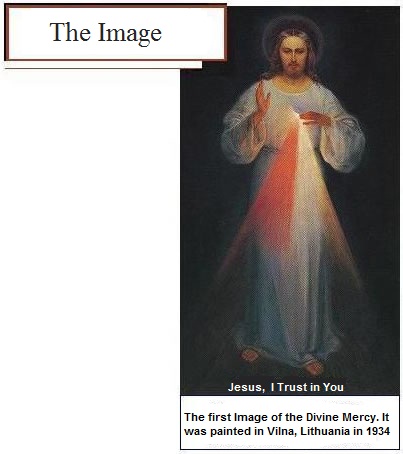


THE IMAGE OF MERCIFUL JESUS.
The Image of the Lord of Divine Mercy was painted by Jesus' own orders given to Sister Faustina on February 22, 1931 in Plock (Poland): "In the evening, when I was in my cell, I saw the Lord Jesus clothed in a white garment. One hand [was] raised in the gesture of blessing, the other was touching the garment at the breast. From beneath the garment, slightly drawn aside at the breast, there were emanating two large rays, one red, the other pale. In silence I kept my gaze fixed on the Lord; my soul was struck with awe, but also with great joy. After a while, Jesus said to me": "Paint an image according to the pattern you see, with the signature: Jesus, I trust in You. I desire that this image be venerated, first in your chapel, and [then] throughout the world ".(Diary 47)
"I promise that the soul that will venerate this image will not perish. I also promise victory over its enemies already here on earth, especially at the hour of death. I myself will defend it as My own glory” (Diary 48)
"I want that this image be painted with a paintbrush, and be solemnly blessed on the first Sunday after EASTER; that Sunday should be named the Feast of the Divine Mercy “(Diary, 49);
"By means of this Image I shall be granting many graces to souls; so let every soul have access to it" (Diary, 570)
"The two rays signify Blood and Water", Jesus explained to Saint Faustina:" The pale ray stands for the Water which makes souls righteous. The red ray stands for the Blood which is the life of souls. These two rays issued forth from the very depths of My tender Mercy when My agonized heart was opened by a lance on the Cross. These rays shield souls from the wrath of My Father. Happy is the one who dwells in their shelter, for the just hand of God shall not lay hold of him" (Diary 299).
One of the soldiers pierced the side of Jesus with a spear, and instantly Blood and Water gushed out. These are the rays of God’s Mercy that are very precious. Jesus revealed that the red ray signifies the last drop of Divine Blood and the white ray signifies a drop of baptismal Water. Both rays also represent the two Sacraments given to us by our Holy Mother Church: the white ray signifies the Sacrament of Penance, and the red ray represents the Eucharist in the Holy Communion. Thus, the two rays in the image of Divine Mercy invite us to frequently participate in the Sacraments which give us strength to discern between good and evil, and help us resist numerous temptations in this world. God is a loving and merciful Father who is always ready to forgive us, his children, all our sins, whenever we go to meet Him in the confessional, with a sincerely repentant heart.
Jesus told Saint Faustina: "I
am offering souls a vessel with which they are to keep coming for
graces to the fountain of mercy. That vessel is this image with the
signature: “Jesus, I trust in You” (Diary
327).
"By means of this image I shall grant many graces to souls. It is to be a reminder of the demands of My mercy, because even the strongest faith is of no avail without works. (Diary742). The painting of the Merciful Jesus painted by Eugenio Kazimirowski, in cooperation with Saint Faustina, was approved for our Lord Jesus: " Not in the beauty of the color, nor of the brush, lies the greatness of this image, but in My grace" (Diary313). In fact, the darkness of the background represents the darkness in the absence of grace. Jesus is the Light.
During the World War Two, the painting remained providentially hidden. If the Image had been exposed, it could have been destroyed due to the Russian occupation and the persecution of the Catholics.
Another
image of Jesus of the Divine Mercy had been painted in 1944 by a
painter named Adolfo Hyla. He made it as a votive offering of
gratitude for the rescue of his family during an accident in the
Second World War. The artist of this second painting was inspired by
the description of Saint Faustina, but completed it according to his
own style and ideas. His painting was consecrated and placed in the
chapel of the convent of Krakow, where it is venerated to date.
Adolfo Hyla’s painting was instrumental in the spreading of the
worship of the Divine Mercy.
The
first painting, painted by Eugenio Kazimirowski, was called the "Holy
Image" by
the Pope John Paul II. It was miraculously saved from the ravages of
the World War Two, and again arose to the light in 1993. A thorough
conservation of this painting was carried out in 2003. Since 2005 it
remains exposed in the central altar of the Sanctuary of Divine Mercy
in Vilna, Lithuania (c/Dominikonu 12).

